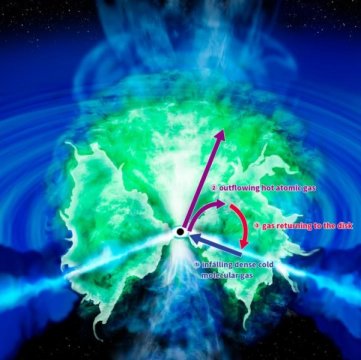[ad_1]
Based on computer simulations and new observations from the Atacama Large Millimeter/submillimeter Array (ALMA), researchers have found that the rings of gas surrounding active supermassive black holes are not simple donut shapes. Instead, gas expelled from the center interacts with infalling gas to create a dynamic circulation pattern, similar to a water fountain in a city park.
Most galaxies host a supermassive black hole, millions or billions of times as heavy as the Sun, in their centers. Some of these black holes swallow material quite actively. But astronomers have believed that rather than falling directly into the black hole, matter instead builds up around the active black hole forming a donut structure.
Takuma Izumi, a researcher at the National Astronomical Observatory of Japan (NAOJ), led a team of astronomers that used ALMA to observe the supermassive black hole in the Circinus Galaxy located 14 million light-years away from the Earth in the direction of the constellation Circinus. The team then compared their observations to a computer simulation of gas falling towards a black hole made with the Cray XC30 ATERUI supercomputer operated by NAOJ. This comparison revealed that the presumptive “donut” is not actually a rigid structure, but instead a complex collection of highly dynamic gaseous components. First, cold molecular gas falling towards the black hole forms a disk near the plane of rotation. As it approaches the black hole, this gas is heated until the molecules break down into the component atoms and ions. Some of these atoms are then expelled above and below the disk, rather than being absorbed by the black hole. This hot atomic gas falls back onto the disk creating a turbulent three dimensional structure. These three components circulate continuously, similar to a water fountain in a city park.
“Previous theoretical models set a priori assumptions of rigid donuts,” explains Keiichi Wada, a theoretician at Kagoshima University in Japan, who lead the simulation study and is a member of the research team. “Rather than starting from assumptions, our simulation started from the physical equations and showed for the first time that the gas circulation naturally forms a donut. Our simulation can also explain various observational features of the system.”
“By investigating the motion and distribution of both the cold molecular gas and warm atomic gas with ALMA, we demonstrated the origin of the so-called ‘donut’ structure around active black holes,” said Izumi. “Based on this discovery, we need to rewrite the astronomy textbooks.”
Story Source:
Materials provided by National Institutes of Natural Sciences. Note: Content may be edited for style and length.
[ad_2]















